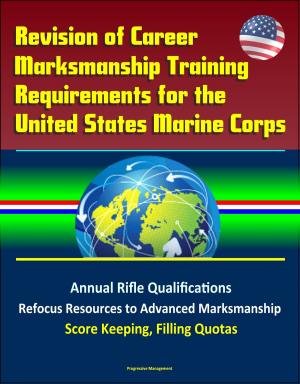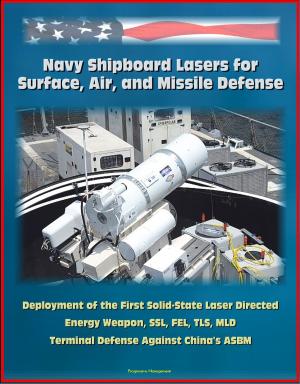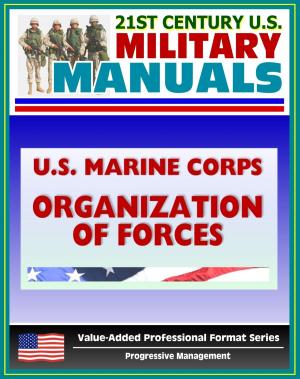Effects of the Subsurface Domain on the Security of the Korean Peninsula: North Korea's Korean People's Navy Submarine Undersea Threat to the Republic of Korea, South Korean Anti-Submarine Warfare
Nonfiction, History, Asian, Asia| Author: | Progressive Management | ISBN: | 9780463117675 |
| Publisher: | Progressive Management | Publication: | June 22, 2018 |
| Imprint: | Smashwords Edition | Language: | English |
| Author: | Progressive Management |
| ISBN: | 9780463117675 |
| Publisher: | Progressive Management |
| Publication: | June 22, 2018 |
| Imprint: | Smashwords Edition |
| Language: | English |
This important December 2017 report has been professionally converted for accurate flowing-text e-book format reproduction.
This thesis analyzes the effects of subsurface forces on security around the Korean Peninsula. It looks at the history, order of battle, and past provocations carried out by the Korean People's Navy (KPN) in the undersea environment and the threats posed to the South. Then, the thesis looks at the Republic of Korea Navy's undersea vulnerabilities, strategy, and recent responses to the North's provocations. Finally, the thesis explores various ways of integrating technology and possible allied cooperation to defend against the relentless provocations from the North. It concludes that integrating unmanned underwater vehicles, creating a wide-area surveillance system, and working with countries sharing common security interests (including the United States and Japan) could significantly improve South Korea's anti-submarine warfare capabilities by providing better indications and warnings of KPN submarine activity in its waters and doubling the number of submarines available to manage the North's large undersea fleet. Although many diplomatic and political hurdles need to be addressed before such strategic military cooperation could occur, the implications for better managing the subsurface domain, not just around the Korean Peninsula, but also in the rest of the region, would be significant.
I. INTRODUCTION * A. MAJOR RESEARCH QUESTION * B. SIGNIFICANCE OF THE RESEARCH QUESTION * C. LITERATURE REVIEW * D. POTENTIAL EXPLANATIONS AND HYPOTHESES * E. RESEARCH DESIGN * F. THESIS OVERVIEW * II. THE NORTH KOREAN SUBMARINE FLEET * 1. Brief History * 2. DPRK Infiltration into and Attacks on the ROK * 3. Acquisition and industry * 4. Current and Future Strategy * III. SOUTH KOREAN SUBMARINE FLEET * A. INTRODUCTION * B. ROKN * 1. ROKN Submarine Force * 2. ROKN Submarine Order of Battle * 3. Acquisition and Industry * C. EVOLUTION OF ROKN ASW TACTICS AND STRATEGY * 1. Before the ROKS Cheonan Incident * 2. Post-ROKS Cheonan Incident * IV. CURRENT AND FUTURE COOPERATION WITH ALLIED SUBMARINE FORCES. * A. U.S. UNDERSEA FORCES IN THE REGION * B. UNDERSEA ACTIVITIES IN THE REGION * C. FUTURE PROSPECTS FOR USN-ROKN UNDERSEA COOPERATION * D. POSSIBLE ROK-USN-JMSDF UNDERSEA COOPERATION * V. CONCLUSION
This important December 2017 report has been professionally converted for accurate flowing-text e-book format reproduction.
This thesis analyzes the effects of subsurface forces on security around the Korean Peninsula. It looks at the history, order of battle, and past provocations carried out by the Korean People's Navy (KPN) in the undersea environment and the threats posed to the South. Then, the thesis looks at the Republic of Korea Navy's undersea vulnerabilities, strategy, and recent responses to the North's provocations. Finally, the thesis explores various ways of integrating technology and possible allied cooperation to defend against the relentless provocations from the North. It concludes that integrating unmanned underwater vehicles, creating a wide-area surveillance system, and working with countries sharing common security interests (including the United States and Japan) could significantly improve South Korea's anti-submarine warfare capabilities by providing better indications and warnings of KPN submarine activity in its waters and doubling the number of submarines available to manage the North's large undersea fleet. Although many diplomatic and political hurdles need to be addressed before such strategic military cooperation could occur, the implications for better managing the subsurface domain, not just around the Korean Peninsula, but also in the rest of the region, would be significant.
I. INTRODUCTION * A. MAJOR RESEARCH QUESTION * B. SIGNIFICANCE OF THE RESEARCH QUESTION * C. LITERATURE REVIEW * D. POTENTIAL EXPLANATIONS AND HYPOTHESES * E. RESEARCH DESIGN * F. THESIS OVERVIEW * II. THE NORTH KOREAN SUBMARINE FLEET * 1. Brief History * 2. DPRK Infiltration into and Attacks on the ROK * 3. Acquisition and industry * 4. Current and Future Strategy * III. SOUTH KOREAN SUBMARINE FLEET * A. INTRODUCTION * B. ROKN * 1. ROKN Submarine Force * 2. ROKN Submarine Order of Battle * 3. Acquisition and Industry * C. EVOLUTION OF ROKN ASW TACTICS AND STRATEGY * 1. Before the ROKS Cheonan Incident * 2. Post-ROKS Cheonan Incident * IV. CURRENT AND FUTURE COOPERATION WITH ALLIED SUBMARINE FORCES. * A. U.S. UNDERSEA FORCES IN THE REGION * B. UNDERSEA ACTIVITIES IN THE REGION * C. FUTURE PROSPECTS FOR USN-ROKN UNDERSEA COOPERATION * D. POSSIBLE ROK-USN-JMSDF UNDERSEA COOPERATION * V. CONCLUSION















